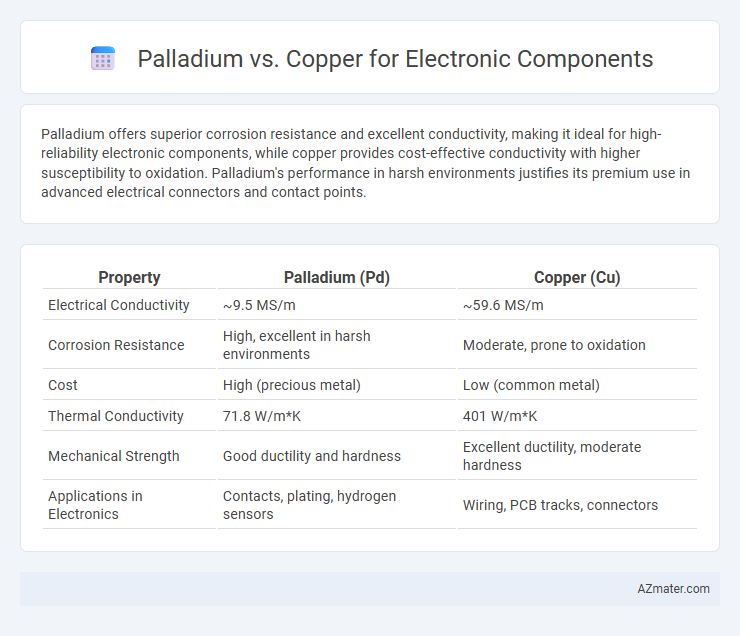Palladium offers superior corrosion resistance and excellent conductivity, making it ideal for high-reliability electronic components, while copper provides cost-effective conductivity with higher susceptibility to oxidation. Palladium's performance in harsh environments justifies its premium use in advanced electrical connectors and contact points.
Table of Comparison
| Property | Palladium (Pd) | Copper (Cu) |
|---|---|---|
| Electrical Conductivity | ~9.5 MS/m | ~59.6 MS/m |
| Corrosion Resistance | High, excellent in harsh environments | Moderate, prone to oxidation |
| Cost | High (precious metal) | Low (common metal) |
| Thermal Conductivity | 71.8 W/m*K | 401 W/m*K |
| Mechanical Strength | Good ductility and hardness | Excellent ductility, moderate hardness |
| Applications in Electronics | Contacts, plating, hydrogen sensors | Wiring, PCB tracks, connectors |
Introduction to Palladium and Copper in Electronics
Palladium and copper are critical materials in electronics, with copper widely used for its excellent electrical conductivity and cost-effectiveness in circuit boards and wiring. Palladium, a precious metal in the platinum group, offers superior corrosion resistance and stability in thin-film applications like multilayer ceramic capacitors and plated-through holes. Electronic components benefit from copper's high conductivity and palladium's durability, enhancing performance and reliability in devices ranging from smartphones to aerospace systems.
Material Properties Comparison
Palladium exhibits superior corrosion resistance and excellent conductivity compared to copper, making it ideal for high-reliability electronic components and harsh environments. Copper provides higher electrical conductivity and is more cost-effective, but it is prone to oxidation, requiring protective coatings for durability. The choice between palladium and copper depends on the balance of performance needs, environmental exposure, and budget constraints in electronic applications.
Conductivity and Performance Metrics
Palladium exhibits lower electrical conductivity than copper, with copper having a conductivity of approximately 5.96 x 10^7 S/m compared to palladium's 9.5 x 10^6 S/m, making copper superior for high-performance electronic components. Despite lower conductivity, palladium offers excellent corrosion resistance and stable electrical performance in harsh environments, benefiting long-term reliability in connectors and contacts. Performance metrics favor copper for efficient current flow and minimal resistive losses, while palladium is preferred for durability and enhanced signal integrity in specific electronic applications.
Cost Analysis: Palladium vs Copper
Palladium's cost per ounce significantly exceeds that of copper, with prices approximately 30 times higher due to its rarity and demand in electronics. Despite palladium's superior corrosion resistance and excellent conductivity, copper remains the preferred choice in electronic components for cost-sensitive applications because of its affordability and adequate performance. Total cost analysis, including raw material, processing, and reliability factors, often favors copper in mass production, while palladium is reserved for high-performance or smaller-scale components where cost is less restrictive.
Corrosion Resistance and Durability
Palladium offers superior corrosion resistance compared to copper, making it ideal for electronic components exposed to harsh environments and moisture. Its durability extends the lifespan of connectors and contacts by preventing oxidation and wear. Copper, while highly conductive, is more prone to corrosion and requires protective coatings to enhance its durability in electronic applications.
Applications in Electronic Components
Palladium is extensively used in multilayer ceramic capacitors (MLCCs) and in plating electronic connectors due to its excellent corrosion resistance and superior electrical conductivity, essential for high-reliability applications such as aerospace and medical devices. Copper dominates in printed circuit boards (PCBs) and wire bonding, offering cost-effective conductivity and thermal management in consumer electronics and telecommunications. The choice between palladium and copper hinges on performance requirements, cost constraints, and environmental resistance needed for specific electronic component applications.
Environmental Impact and Sustainability
Palladium's extraction involves complex mining processes that generate significant environmental pollution and energy consumption compared to copper, which is more abundant and recyclable with lower ecological footprint. Copper's higher recyclability and widespread use in wiring and electronics enhance sustainability by reducing mining demand and conserving natural resources. Sustainable electronics benefit from copper's lower environmental impact, while palladium remains critical for certain high-performance components despite its environmental challenges.
Manufacturing Processes and Compatibility
Palladium offers superior corrosion resistance and excellent solderability compared to copper, making it ideal for high-reliability electronic components in harsh environments. Manufacturing processes with palladium often involve plating techniques that enhance conductivity and surface hardness, whereas copper requires careful oxidation control during processing to maintain performance. Compatibility with lead-free solder and advanced PCB technologies favors palladium, while copper remains cost-effective for large-scale production but demands additional protective coatings to prevent degradation.
Reliability and Lifespan Considerations
Palladium offers superior corrosion resistance and excellent solderability, enhancing the reliability and lifespan of electronic components compared to copper, which is more prone to oxidation and signal degradation over time. The stable contact resistance of palladium ensures consistent performance in high-frequency applications, while copper's susceptibility to electromigration can reduce component longevity. For critical and long-term use, palladium's durability in harsh environments significantly surpasses copper, making it the preferred choice in premium electronic manufacturing.
Future Trends in Electronic Material Selection
Palladium's superior corrosion resistance and excellent conductivity are driving its increased adoption in high-reliability electronic components, particularly in connectors and plating applications where longevity and performance are critical. Copper remains dominant due to its cost efficiency and excellent electrical conductivity, but ongoing advancements in alloy formulations and surface treatments aim to enhance its durability and corrosion resistance. Emerging trends highlight the integration of palladium-copper composites and alternative materials to balance cost and performance, meeting the growing demand for miniaturization and high-frequency applications in future electronic devices.

Infographic: Palladium vs Copper for Electronic Component
 azmater.com
azmater.com